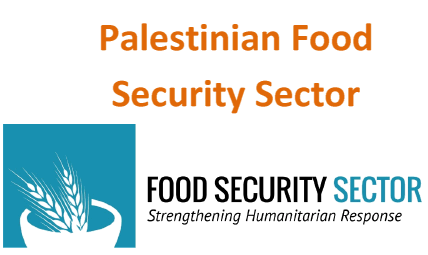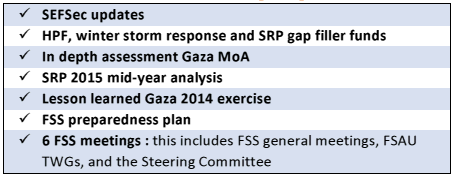
FSS 2015 2nd Quarter Highlights
In brief
SEFSec survey
New analysis methodology: PCBS analysts are running their testing to validate and comment on the revised proposed methodology agreed by the Food Security Analysis Unit (FSAU). FAO and WFP technical staff have been working very close with PCBS staff on this regard. It is expected that this effort will generate some minor modifications at the technical statistical level to the methodology endorsed by the FSAU, as PCBS should assure full statistical validity and consistency for the new methodology. This phase is part of the wider process aiming at increasing PCBS ownership of the SEFSec as well as improving local capacity for future implementation of the survey.
SEFSec 2014 data collection: it started in both West Bank and Gaza in April 2014. The sample size is around 5,000 House Holds (HHs) in the West Bank and 2,500 HHs in Gaza. The data collection was completed by the end of June. PCBS is adopting a series of innovations for this round of the SEFSec which are setting higher standards in the institution:
• Panel data methodology: PCBS has retrieved data from same HHs interviewed last year. This also includes follow up on split HHs. For this reason, more efforts and time were needed on the ground.
• Digitalized data collection: PCBS made use of tablets to enter data in the field. This will dramatically reduce data-entry time and avoid typing errors even for future editions .
A first SEFSec brief summary of findings will be ready by the beginning of September. A full report is scheduled to be issued in December 2015.
HPF, winter storm response and SRP gap filler
HPF is the Humanitarian Pooled Fund managed by OCHA. In January two winter storms hit Palestine. The FSS team worked with MoA and active partners in order to assess the damages caused by the storms. Two projects were identified for receiving funds, one in Gaza Strip and one in the West Bank, implemented respectively by PARC and ESDC.
In February 2015 the Emergency Relief Coordinator (ERC) approved the new Country Based Pooled Funds (CBPF) guidance. The adoption of the new HPF guidelines have begun working on transforming the oPt fund towards closer alignment with the new guidelines. There are new methodologies around prioritization, the strategic character and governance of the funds' review processes, grants management – including the online Grants Management System (GMS) and financial systems and modalities.
The HPF called fora standard allocation through a call for proposals that has been launched in the 2nd quarter, at the discretion of the HC and linked to the priorities of the SRP. The two selected projects resulted from this process.
In-depth assessment Gaza MoA
The FSS continued to follow up the work at MoA in Gaza in order to finalize the data-entry- process. No more financial support was provided from the FSS budget after the end of March. FAO in close coordination with FSS covered the required data-entry additional staff after March. According to MoA, a number of 25,233 questionnaires (for 22,000 farmers and breeders) were entered into the database. A report of final output is expected to be issued by MoA in August.
SRP 2015 mid-year analysis
The FSS analysed the status of the projects under the Strategic Response Plan 2015. The level of funding for the FSS reached the 38% of the total amount requested. The graph below shows how funds granted to FSS partners by 30th June 2015 are distributed at country level:
More in details, considering also the geographical distribution of the projects, some unbalances come out:
This quick overview clearly shows that that projects focusing on promoting and protecting the livelihoods of rural farmers, herders, breeders, fishers in order to decrease their dependence on direct food aid and increase their resilience are not getting the adequate funding. The same applies to Cash for Work in Gaza.
In terms of beneficiaries reached by FSS activities, 90% of people targeted for food aid have been reached although more resources will have to be mobilised to fulfil the task for 2015.
Lessons learned Gaza 2014 exercise
Following the recommendation of the Steering Committee, the FSS carried out a lessons learnt exercise based an on-line survey focused on the role of the FSS during the last conflict in Gaza in 2014.
In brief, the graph below shows the findings of the survey in terms of appreciation of FSS services and products delivered during the conflict:
The results and outcome of the survey have been shared with FSS partners. Findings and suggested recommendations of this exercise have been consolidated into a presentation given to FSS partners in Gaza in early June for further elaboration and suggestions. The recommendations include the following:
•More extended and detailed information about FSS partners activities
• Better IM tools and more engagement from all partners in feeding info
• More involvement and coordination with line ministries
• More guidance for standards and best practices
• Improved resource mobilisation
• Enhanced beneficiaries selection process
Susiya community relocation
The FSS took part of an inter-cluster visit to the community at Susyia, south Hebron. A contingency plan has been elaborated and finalised. Susiya community is already part of the regular food distribution system (WFP-UNRWA) and the community has put in place coping mechanisms to mitigate the impact of the demolition on their food supply.
Similarly, with regard to their livestock, the agreed contingency plan will support the community with animal shelter.
The issue of forcible displacement of people and demolition of Palestinian assets remain a FSS major concern. Destruction agricultural-livelihood resources continues to be largely not addressed, amid apparently intensification of controls and demolition orders.
FSS Preparedness plan
The FSS Contingency Plan aims to provide a common contingency planning framework for the sector as well as within the wider framework managed by the Inter-Cluster Coordination Group (ICCG).
The Plan covers the period from June 2015 to December 2015 and includes potential scenarios, their humanitarian and operational consequences and the related coordination arrangements.
In both West bank and Gaza Strip the contingency plan have been developed for responding to foreseeable new threats in order to ensure, as much as possible, the continuity of services and humanitarian assistance to the target populations. FSS partners though the emergency and preparedness working group led the contingency planning process. Final elaboration of the plan was discussed in meetings held in May and June.
Cluster System Review
The FSS in close coordination with OCHA and other cluster contributed to the making of the cluster architecture review, including an on-line consultation in April.
During the month of May, the process produced first outcomes and recommendations. The FSS in both West Bank and Gaza Strip joined the cluster review focus groups discussions. In parallel the FSS participated to two separate meetings carried out with PA line Ministries and donors to ensure feedback/inputs from their sides are incorporated into the final output and used to inform the final process of the cluster review
MIRA review
MIRA is the Multi-cluster Initial Rapid Assessment, a standard tool that was utilized in Gaza last year in the aftermath of the war. The ICCG promoted a revision of the tool in order to customize it for future uses in the country. The FSS team contributed to this process in April.
FS dashboard
The FS Dashboard aims at replacing the previous FS Watch tool by providing a more dynamic and continuously freely accessible source of data to the wider public.
Following the FSS stakeholders' recommendation to have updated food security indicators and figures the FSS team have worked with OCHA, who is providing IT support. The FSS Dashboard draft version has been shared among the FSAU members for further comments and improvements. The Dashboard is not available for public consultation yet.
Information Managment (IM): MoA/MoSA databases
The information management within the FSS adds value by collecting, processing, analyzing and disseminating information. FSS explored the options to establish an Information Management system that ensures timely sharing of reliable and relevant data through joint information systems that: provides prompt information about who is doing what and where, identifies those most in need, tracks trends in coverage and access over time against key performance indicators, highlights the need for mutual cooperation in adapting on-going programmes to the evolving and makes use of, and manages contents through dedicated IT and web-based resources.
In the meantime, the FSS continued asking FSS partners to update the 4 Ws covering the period January 2012 to March 2015. The FSS was in charge for entering, cleaning and reformatting data, as well as verifying data quality. The updated 3-4Ws has been uploaded to the FSS website, assuring free access to FSS partners and wider public.
The FSS continues to work for producing and developing a damages-response matrix in regard to the last war in Gaza in order to appreciate the level of achievements so far reached in addressing the needs originated during the conflict. The work os in progress, in strict cooperation with the MoA and other FSS partners who have been implementing activities in this regard.
Resilience Task Force at global Food Security Cluster (gFSC) level
The gFSC constituted a task force on resilience in November 2014 at the last gFSC partners meeting in Rome. The Palestinian FSS is part of it.
A questionnaire has been developed by the gFSC Task Force and circulated through the FSS to relevant food security stakeholders at country level. The survey intended to explore the status of inclusion of resilience in various countries as well as in other clusters.
Contacts
Lead agencies FAO and WFP
Ciro Fiorillo – ciro.fiorillo@fao.org; Daniela Owen -daniela.owen@wfp.org
Sector focal points
Marco Ferloni – marco.ferloni@foodsecuritycluster.net +972 (0) 546773171
Hosne Barakat – hosne.barakat@foodsecurityluster.net + 972 (0) 546773161
Anas Musallam – anas.musallam@foodsecuritycluster.net +972 (0) 592030026
Download Document Files: https://unispal.un.org/pdfs/FSS_2ndQuarter15.pdf
Document Type: Report
Document Sources: Food Security Sector, Food and Agriculture Organization (FAO), World Food Programme (WFP)
Subject: Agriculture, Assistance, Food, Gaza Strip, Humanitarian relief, Living conditions, Poverty
Publication Date: 31/08/2015






